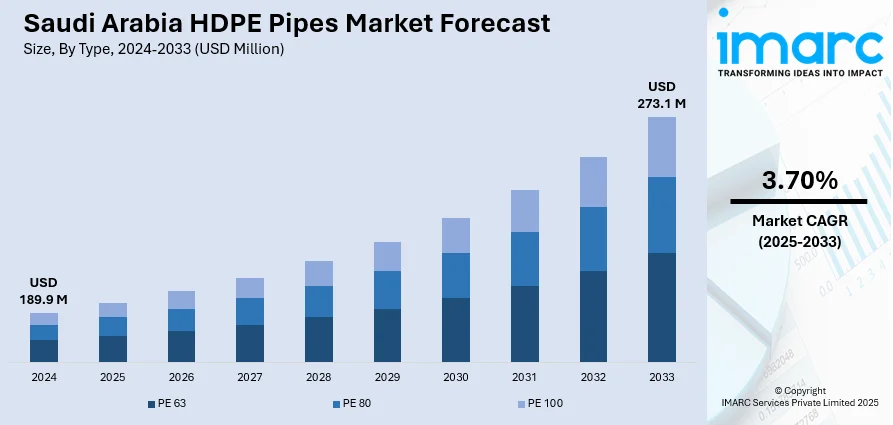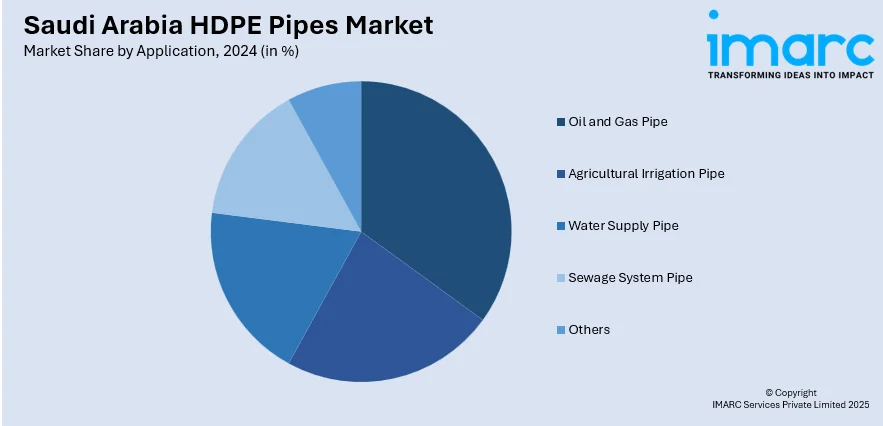
Saudi Arabia HDPE Pipes Market Size, Share, Trends and Forecast by Type, Application, and Region, 2025-2033
Saudi Arabia HDPE Pipes Market Overview:
The Saudi Arabia HDPE pipes market size reached USD 189.9 Million in 2024. Looking forward, IMARC Group expects the market to reach USD 273.1 Million by 2033, exhibiting a growth rate (CAGR) of 3.70% during 2025-2033. The market is driven by expanding infrastructure projects under Vision 2030, demand for durable water and sewage systems, and growth in construction. Additionally, sustainability initiatives and the shift toward recyclable materials enhance adoption. The oil & gas sector’s need for corrosion-resistant piping is further augmenting the Saudi HDPE pipes market share. Government investments in modern utilities also play a key role.
|
Report Attribute
|
Key Statistics
|
|---|---|
|
Base Year
|
2024
|
|
Forecast Years
|
2025-2033
|
|
Historical Years
|
2019-2024
|
| Market Size in 2024 | USD 189.9 Million |
| Market Forecast in 2033 | USD 273.1 Million |
| Market Growth Rate 2025-2033 | 3.70% |
Saudi Arabia HDPE Pipes Market Trends:
Increasing Demand for HDPE Pipes in Infrastructure Development
The rising infrastructure development projects, particularly in water supply, sewage systems, and irrigation are majorly driving the Saudi Arabia HDPE pipes market growth. In January 2025, new factories stood at 103, while industrial licenses issued stood at 63, with investments totaling SR900 million and more than 1,504 job opportunities created. This industrial expansion is fueling the demand for infrastructure materials, such as high-density polyethylene (HDPE) pipes, as part of Vision 2030, which targets the establishment of 36,000 factories by 2035, of which 4,000 are automated. The development also coincides with an upturn in manufacturing activity, with a 1.3% rise year-on-year in the industrial production index. The government’s initiative emphasizes modernizing utilities and expanding urban infrastructure, driving demand for durable and corrosion-resistant piping solutions. HDPE pipes are preferred for their flexibility, long lifespan, and resistance to chemicals, making them ideal for large-scale projects such as the NEOM smart city and the Riyadh Water Transmission System. Additionally, the growing construction sector, including residential and commercial developments, is enhancing the adoption of HDPE pipes for plumbing and drainage applications. With increasing investments in sustainable infrastructure, the market is expected to witness steady growth, supported by government policies promoting efficient water management and reduced leakage rates in piping networks.

Shift Toward Sustainable and Recyclable Piping Solutions
Sustainability is becoming a key driver in Saudi Arabia’s HDPE pipes market, with a growing preference for eco-friendly and recyclable materials. HDPE pipes are gaining traction due to their lower carbon footprint compared to traditional materials including concrete and metal. The Saudi Green Initiative encourages the use of environmentally friendly construction materials, aligning with global trends toward circular economies. Manufacturers are also focusing on producing high-quality, recyclable HDPE pipes to meet the demand for sustainable infrastructure. Furthermore, the oil and gas sector is adopting HDPE pipes for corrosion-resistant and leak-proof fluid transportation, reducing environmental risks. Thus, this is also creating a positive Saudi Arabia HDPE pipes market outlook. As awareness of sustainable practices grows, the market is expected to see increased investments in advanced HDPE pipe technologies, reinforcing Saudi Arabia’s commitment to environmental conservation and efficient resource utilization.
Saudi Arabia HDPE Pipes Market Segmentation:
IMARC Group provides an analysis of the key trends in each segment of the market, along with forecasts at the country level for 2025-2033. Our report has categorized the market based on type and application.
Type Insights:
- PE 63
- PE 80
- PE 100
The report has provided a detailed breakup and analysis of the market based on the type. This includes PE 63, PE 80, and PE 100.
Application Insights:

- Oil and Gas Pipe
- Agricultural Irrigation Pipe
- Water Supply Pipe
- Sewage System Pipe
- Others
A detailed breakup and analysis of the market based on the application have also been provided in the report. This includes oil and gas pipe, agricultural irrigation pipe, water supply pipe, sewage system pipe, and others.
Regional Insights:
- Northern and Central Region
- Western Region
- Eastern Region
- Southern Region
The report has also provided a comprehensive analysis of all the major regional markets, which include Northern and Central Region, Western Region, Eastern Region, and Southern Region.
Competitive Landscape:
The market research report has also provided a comprehensive analysis of the competitive landscape. Competitive analysis such as market structure, key player positioning, top winning strategies, competitive dashboard, and company evaluation quadrant has been covered in the report. Also, detailed profiles of all major companies have been provided.
Saudi Arabia HDPE Pipes Market News:
- October 29, 2024: Saudi Arabia's National Water Company (NWC) announced plans to award USD 40 million worth of the mega-contract for the expansion of the Riyadhe sewage system, from which 18.5 kilometers will be HDPE pipes. The project, which will be implemented in Al-Munisiyah, involves pipe diameters between 200 mm and 500 mm and is expected to be completed in the second quarter of 2026.
Saudi Arabia HDPE Pipes Market Report Coverage:
| Report Features | Details |
|---|---|
| Base Year of the Analysis | 2024 |
| Historical Period | 2019-2024 |
| Forecast Period | 2025-2033 |
| Units | Million USD |
| Scope of the Report |
Exploration of Historical Trends and Market Outlook, Industry Catalysts and Challenges, Segment-Wise Historical and Future Market Assessment:
|
| Types Covered | PE 63, PE 80, PE 100 |
| Applications Covered | Oil and Gas Pipe, Agricultural Irrigation Pipe, Water Supply Pipe, Sewage System Pipe, Others |
| Regions Covered | Northern and Central Region, Western Region, Eastern Region, Southern Region |
| Customization Scope | 10% Free Customization |
| Post-Sale Analyst Support | 10-12 Weeks |
| Delivery Format | PDF and Excel through Email (We can also provide the editable version of the report in PPT/Word format on special request) |
Key Questions Answered in This Report:
- How has the Saudi Arabia HDPE pipes market performed so far and how will it perform in the coming years?
- What is the breakup of the Saudi Arabia HDPE pipes market on the basis of type?
- What is the breakup of the Saudi Arabia HDPE pipes market on the basis of application?
- What is the breakup of the Saudi Arabia HDPE pipes market on the basis of region?
- What are the various stages in the value chain of the Saudi Arabia HDPE pipes market?
- What are the key driving factors and challenges in the Saudi Arabia HDPE pipes market?
- What is the structure of the Saudi Arabia HDPE pipes market and who are the key players?
- What is the degree of competition in the Saudi Arabia HDPE pipes market?
Key Benefits for Stakeholders:
- IMARC’s industry report offers a comprehensive quantitative analysis of various market segments, historical and current market trends, market forecasts, and dynamics of the Saudi Arabia HDPE pipes market from 2019-2033.
- The research report provides the latest information on the market drivers, challenges, and opportunities in the Saudi Arabia HDPE pipes market.
- Porter's five forces analysis assist stakeholders in assessing the impact of new entrants, competitive rivalry, supplier power, buyer power, and the threat of substitution. It helps stakeholders to analyze the level of competition within the Saudi Arabia HDPE pipes industry and its attractiveness.
- Competitive landscape allows stakeholders to understand their competitive environment and provides an insight into the current positions of key players in the market.
Need more help?
- Speak to our experienced analysts for insights on the current market scenarios.
- Include additional segments and countries to customize the report as per your requirement.
- Gain an unparalleled competitive advantage in your domain by understanding how to utilize the report and positively impacting your operations and revenue.
- For further assistance, please connect with our analysts.
 Request Customization
Request Customization
 Speak to an Analyst
Speak to an Analyst
 Request Brochure
Request Brochure
 Inquire Before Buying
Inquire Before Buying




.webp)




.webp)












